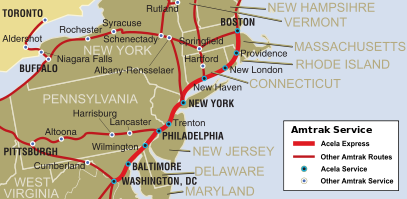Acela Express
 Acela Express |
|||
|---|---|---|---|
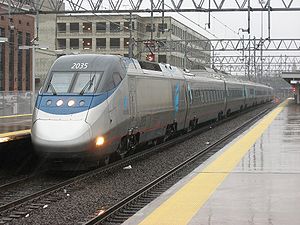 Amtrak Acela Express train, led by power car #2035, at New Haven Union Station in New Haven, CT. |
|||
| Overview | |||
| Service type | Regional tilting train | ||
| Status | Operating | ||
| Locale | Northeastern United States | ||
| First service | December 11, 2000 | ||
| Current operator(s) | Amtrak | ||
| Average ridership | 8,272 (2009 per day) 3,019,627 (2009 total)[1] |
||
| Route | |||
| Start | Boston, MA | ||
| No. of intermediate stops | 14 | ||
| End | Washington, DC | ||
| Distance travelled | 456 mi (734 km) | ||
| Average journey time | 7 hours | ||
| Service frequency | 20 per day[2] | ||
| Train number(s) | 2100 - 2290 | ||
| On-board services | |||
| Class(es) | Business and first class | ||
| Disabled access | Fully accessible | ||
| Seating arrangements | Airline-style coach seating | ||
| Catering facilities | On-board café, and at-seat meals in first class | ||
| Baggage facilities | Checked baggage available at selected stations | ||
| Technical | |||
| Gauge | 1,435 mm (4 ft 8 1⁄2 in) Standard gauge | ||
| Operating speed | 150 mph (240 km/h) maximum 70 mph (110 km/h) average |
||
|
|||
Acela Express (often simply Acela) is Amtrak's high-speed rail service along the Northeast Corridor (NEC) in the Northeast United States between Washington, D.C., and Boston via Baltimore, Philadelphia, and New York. It uses tilting technology which allows the train to travel at higher speeds on the sharply curved NEC without disturbing passengers, by lowering lateral centrifugal forces,[3] based on the concept of banked turns.
Acela Express trains are the only true high-speed trainsets in North America; the highest speed they attain is 150 mph (240 km/h), though they average less than half of that. Acela has become popular with business travelers and by some reckoning has captured over half of the market share of air or train travelers between Washington and New York.[4] Between New York and Boston the Acela Express has up to a 37% share of the train and air market.[5][6]
The Acela gets top billing as Amtrak's premier route, and carries over 3 million passengers annually. However, the busiest Amtrak route is the somewhat slower Northeast Regional, which had 6.9 million riders in 2009 due to its lower fares and greater number of stops than the Acela. The Acela Express is one of the few Amtrak lines to operate at a profit; the two train lines generate more than half of Amtrak's total revenue.[1]
Contents |
Origins and history
Development
On March 9, 1999, Amtrak unveiled its plan for a true high-speed rail service, the Acela Express.[7] Twenty new trains were to be purchased and operated on the busy Northeast Corridor.[8] Several engineering changes were made to the corridor to make it suitable for the trains' operation. Besides straightening curves, it was necessary to infill electrification along the entire 470-mile-long route as the Acela is an entirely electric train.[8] Several grade crossings were also upgraded or removed in the interest of public safety.[9]
Preparation for the train itself had begun in earnest in October 1994;[10] at which point Amtrak had requested bids from train manufacturers to design a trainset that could negotiate the crowded Northeastern Corridor at up to 150 miles per hour (240 km/h). A joint project set up by Bombardier (75%) and GEC Alsthom (now Alstom) (25%) was selected for the project in March 1996.[10] There was a disagreement between Amtrak and the manufacturing consortium over cost overruns and maintenance bills; this issue was not settled for several years, until March 2004.[11][12] However the development of the project was not interrupted, and an inaugural VIP run of the Acela came on November 17, 2000[13] followed by the first revenue run on December 11, although these were a few months past an earlier intended date.[14]
The Acela service can be largely considered a success; by 2005 Amtrak's share of the transport market between New York and Boston had reached 40% from 18% pre-Acela.[15] With the increasing popularity of the faster and more modern Acela Express, the Metroliner service was phased out;[16] the last operated on October 27, 2006.[17] While the average speed of the Acela in operation falls far short of common definitions of high-speed rail,[18] spending much of its time on the route at less than 100 mph (161 km/h), this has not prevented it from having a large impact on the routes that it serves. Due to the level of popularity experienced, more Acela Express services were added in September 2005,[19] and additional trains may be purchased in order to run further simultaneous services.[20] By August 2008 crowding had become noticeable onboard.[21]
Branding
The Acela name (pronounced /əˈsɛlə/ ə-SEL-ə) was announced on March 9, 1999 as a part of the original announcement of the service itself.[22] This was originally intended as a rebranding of most of Amtrak's Northeast services,[23] forming three levels: Acela Express, Acela Regional, and Acela Commuter.[24] The name "Acela" is meant to be evocative of acceleration and excellence.[25][26]
At that time, there were three classes of trains on the Northeast Corridor (and its extension south to Newport News, Virginia)—the hourly Philadelphia-New York Clockers, the express Metroliners, and the umbrella term NortheastDirect, applied to all other local trains on the corridor (in addition to unique names assigned to each departure). Empire Service trains used the Empire Corridor from New York City to Niagara Falls, and Keystone Service ran along the Keystone Corridor from Philadelphia to Harrisburg. Other named trains also used the corridors, branching off or continuing beyond their stations.
The original plan included renaming the Empire, Keystone, and NortheastDirect services to Acela Regional, while the Metroliners would be replaced with the new Acela Express service. However, the Empire and Keystone services retained their original names.
The Acela Regional name was first applied to NortheastDirect trains 130–133 on January 31, 2000.[27] Those trains, 130 and 131 running weekdays only and 132 and 133 running every day, were the first electrified trains to run on the full Northeast Corridor.[28][29] As more trains were electrified, they too were rebranded. In 2003, due to confusion between the lower-speed Acela Regional trains and the Acela Express, the Acela branding was removed from the NortheastDirect service (now the Northeast Regional) and the Acela Commuter had its name changed back to the Clocker for a similar reason and ultimately discontinued on October 28, 2005.[30]
Engineering
Train design
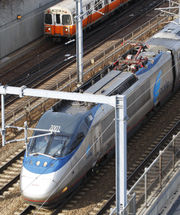
The Acela trainset is a unique train designed specifically to satisfy very specific U.S. governmental rolling stock requirements. These requirements are significantly different from anywhere else in the world, including countries that have a highly functional high speed rail network. Most manufacturers who bid on the Acela were unable to meet these requirements, bringing up cost and complication for the manufacture of the trains, leaving only one manufacturer, and requiring that manufacturer to make significant engineering changes to their standard designs. These specifications are not a result of specific Northeast Corridor track conditions. Although the design of the trains, with identical 6,000 horsepower (4,470 kW) power cars at each end which operate on a voltage of 11,000 volts AC, and either 25 or 60 hertz (cycles per second) frequency, resemble France's TGV, the only components directly derived from the TGV are the 4 asynchronous AC traction electric motors (per power car).
The tilting carriages are based upon Bombardier's earlier LRC trains used on VIA Rail rather than the TGV's articulated trailers, and the locomotives and passenger cars are much heavier than those of the TGV in order to meet the United States Federal Railroad Administration's different approach to rail crash standards.[31] The Tier II crash standards, adopted in 1999, have also resulted in the passenger cars being designed without steps and trapdoors, which means that the trainsets can only serve stations with high-level platforms—this currently restricts them to lines with high-level platforms such as the Northeast Corridor. Acela trains are semi-permanently coupled and are referred to as trainsets. Bombardier later used the Acela Express's carriage design and a diesel/gas turbine variant of the power car for their experimental JetTrain.[32]
Operating speeds and limitations
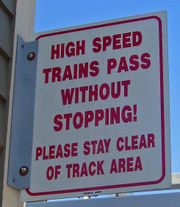
With a top speed of 150 mph (241 km/h) the Acela Express is the only service in North America that exceeds the U.S. Department of Transportation's 125 mph (201 km/h) definition of high speed rail. The Acela achieves an average speed of 80 mph (129 km/h) between Washington and New York, which is comparable to the Denver Zephyr service that ran at an average speed of 77 mph (124 km/h) between Chicago and Denver in the early 1960s. The highest speed attained by Acela Express is 150 mph (241 km/h) on two sections of track in Rhode Island and Massachusetts. There are also many miles of track, especially east of New Haven, that have been upgraded to allow maximum speeds in excess of 110 mph (177 km/h). South of New York, Acela Express is limited to 135 mph (217 km/h), even though several stretches of track there are straight enough to allow 150 mph (241 km/h) speeds. The limiting factor is stated to be the overhead catenary support system which was constructed prior to 1935 and lacks the constant-tension features of the new catenary east of New Haven, although in the late 1960s the Pennsylvania Railroad did run Metroliner test trains as fast as 164 mph (264 km/h) and briefly intended to run the Metroliner service at speeds reaching 150 mph (241 km/h). Although the Acela Express trainsets are capable of 165 mph (266 km/h) operation, FRA regulations do not permit any speeds above 150 mph (241 km/h) on tracks that are shared with freight and slower passenger trains regardless of circumstances, and for Acela Express trains to run above 150 mph (241 km/h) it would require purpose-built dedicated track in a separate right of way.
The slowest section of the electrified NEC is the portion owned by Metro-North Railroad and the Connecticut Department of Transportation between New Haven, CT and New Rochelle, NY. Trains here are limited to only 90 mph (145 km/h) on a 4 miles (6.4 km) stretch in New York State, and to 75 mph (121 km/h) between the New York state line and New Haven. Additionally, tilting is not allowed anywhere on Metro-North or ConnDOT (Connecticut Dept. of Transportation) property. At a maximum 4.2° tilt,[3] the Acela Express trainset would pass other trains on parallel tracks only 10 inches (25 cm) away, which is too close for FRA-mandated clearances. ConnDOT has a number of projects either planned or underway that will upgrade the catenary system,[33] replace outdated bridges, and straighten certain sections of the New Haven Line to eventually enable the Acela trains to run at their 150 mph (241 km/h) top speed.
The scheduled transit time for the 5:00 a.m. departure from Washington, D.C., (the quickest stopping pattern) to Boston's South Station on Acela Express service is roughly 6 hours 36 minutes. Allowing for the fifteen-minute scheduled layover in New York City, the average speed is 72 mph (116 km/h) for the 456 miles (734 km) trip. For the 225 miles (362 km) journey between Washington, D.C., and New York's Penn Station, the transit time is 2 hours 48 minutes, an average speed of 80 mph (129 km/h). If the infrastructure supporting the Acela were upgraded to allow for an average speed of 125 mph (201 km/h), the current 6.5 hour journey between Boston and Washington would be just under four hours and 45 minutes.
On July 9, 2007, Amtrak introduced two limited-stop trains. Train 2105 left New York Penn Station at 6:50 a.m, made only one stop, in Philadelphia, and arrived in Washington at 9:25 a.m. Northbound, train 2120 departed Washington at 3:55 p.m., stopped in Philadelphia, and arrived in New York at 6:30 p.m. This shortened the trip between the two cities to just 2 hours 35 minutes, making the trip roughly an hour faster than some of the Northeast Regional train services. These trains were an experiment on Amtrak's part to find ways to expedite travel time on the Acela despite the speed restrictions on certain parts of the line. Amtrak has since dropped these two limited-stop trains. In the Amtrak Northeast Corridor 1 train schedule effective August 4, 2008, trains 2105 and 2120 are not listed.[34]
High speed issues
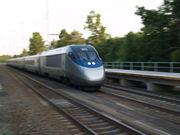
The dense population of the northeastern United States makes the Northeast Corridor the most heavily traveled portion of the American passenger rail system. Two-thirds of rail passengers in the United States live in New York City, also home to the nation's busiest rail passenger station, Penn Station.[35]
In order to compete with airliners, Amtrak needed to increase the speed of trains in the region. However, the former Shore Line, from New Haven to Boston, is burdened by sharp turns and grade crossings, the crossings being especially of concern in regard to high-speed rail.[36][37] There was little support for building an entirely new railway as had been done for Japan's Shinkansen ("Bullet Train"), Spain's AVE, France's TGV and Germany's Intercity-Express. A former "high speed rail" alignment from New Haven to Boston was built in the 1880s, but was gradually abandoned in sections ending in 1955, eventually becoming Airline State Park.
Tilting enables passengers to ride more comfortably on curved sections of track faster than would otherwise be possible, by leaning into the bend. The technology has been implemented on other service lines such the British Rail Class 390 trains which run at a speed of 125 miles per hour (201 km/h) on Britain's Victorian era rail lines.[38] Acela trainsets tilt above 60 mph on most of the system, but some segments of track in the Northeast Corridor are too close together for the carriages to safely tilt while maintaining FRA minimum space between trains on parallel tracks. Furthermore, Metro-North Railroad restricts tilting on the segment of track north of New York owned by them. While the system was originally designed for a 6.8° tilt, the cars were redesigned 4 inches wider to accommodate wider seats and aisles that reduced allowable tilt to a more modest 4.2° to fit within the clearance constraints of the existing tracks.[39][40] Traveling at higher than 135 mph also requires constant-tension catenary, which is only implemented on the more modern catenary system north of New York. South of New York the trains are restricted to 135 mph. By comparison, Northeast Regional and the defunct Metroliner service reach 124 mph (after Amtrak took over from Penn Central and slowed down the service). Acela trainsets can achieve 165 mph[41] but are restricted to 150 mph due to track conditions, other traffic, FRA regulations, and other factors.
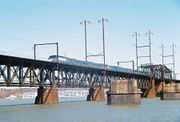
| Acela Express | |||||||||||||||||||||||||||||||||||||||||||||||||||||||||||||||||||||||||||||||||||||||||||||||||||||||||||||||||||||||||||||||||||||||||||
|---|---|---|---|---|---|---|---|---|---|---|---|---|---|---|---|---|---|---|---|---|---|---|---|---|---|---|---|---|---|---|---|---|---|---|---|---|---|---|---|---|---|---|---|---|---|---|---|---|---|---|---|---|---|---|---|---|---|---|---|---|---|---|---|---|---|---|---|---|---|---|---|---|---|---|---|---|---|---|---|---|---|---|---|---|---|---|---|---|---|---|---|---|---|---|---|---|---|---|---|---|---|---|---|---|---|---|---|---|---|---|---|---|---|---|---|---|---|---|---|---|---|---|---|---|---|---|---|---|---|---|---|---|---|---|---|---|---|---|---|
|
|||||||||||||||||||||||||||||||||||||||||||||||||||||||||||||||||||||||||||||||||||||||||||||||||||||||||||||||||||||||||||||||||||||||||||
Acela service was originally expected in late 1999, but various problems appeared. The catenary system was not able to support the speeds originally intended between Washington and New York, but the more modern system between New York and Boston allows the higher speeds. A brief political controversy drew attention to the decreased 4.2° tilt, but this was not to be the root of the speed problem, as the tracks from New York to Boston are similar to those between New York and Washington, and the tilt mechanism is not the factor that allows the high speeds.[39][40][42] After a series of delays, the first Acela Express service began on December 11, 2000, a year behind schedule.[43]
With the completion of electrification between New Haven and Boston, all trains on the line have become faster. Acela travels between Boston and New York in about three and a half hours (an improvement of half an hour). New York to Washington runs take two hours and forty-five minutes (still slightly longer than Penn Central's Metroliner trains ran in the late 1960s before Amtrak took over). These schedules, as well as the relative convenience of rail as opposed to air travel especially after September 11, 2001, and direct downtown-to-downtown service have made the Acela Express more competitive with the Northeast air shuttles.
Service
Composition
The Acela Express trainset consists of two power cars, a cafe car, a first class car, and four business class cars, semi-permanently coupled together. The train has newer seats than regional service counterparts. The first class car has 43 seats and there are 260 business class seats on each trainset. Business class cars have 4 seats across (2 seats across on each side) and four-seat tables. First class has 3 seats across (1 on one side, 2 on the other side) and four seat tables. The car adjacent to first class is designated as the quiet car, where passengers are asked to refrain from loud talking and mobile phone conversations.
Automatic sliding doors provide access between cars throughout the length of the train and reduce noise. Baggage may be stowed in overhead luggage compartments, or underneath the passenger's seat. Reservations guarantee seating but seats themselves are not assigned. Acela trains are also wheelchair-accessible.
Staffing and operation
Generally Amtrak train crews consist of an engineer, a conductor, and at least one assistant conductor. Acela trains also have an on-board service crew consisting of two First Class attendants and a Cafe Car attendant. In addition to the buffet service provided in the Cafe Car, on some trains, a cart attendant will also provide a steward service, serving refreshments throughout the train. First Class passengers are served meals at their seats on all services.
At Amtrak, the On Board Service is considered separate and subordinate to the Train and Engine crews. Acela maintenance is generally taken care of at the Ivy City facility in Washington, DC, Sunnyside Yard in Queens, NY or Southampton St. Yard in Boston, MA.
The Acela trainsets are currently being refurbished at the Penn Coach Yard, next to 30th Station in Philadelphia, PA. These refurbishments include new blue leather seats throughout the trainset and eventually totally remodeled cafe cars with more seating than the previous configuration allowed.
Wireless Internet access
Wireless Internet station service began in 2004, originally through AT&T Wireless.[44] In March 2007, Amtrak's vice president for marketing and product management announced that the Northeast Corridor would soon get wireless Internet service.[45] On October 29, 2009, Amtrak announced that it would begin deploying Wi-Fi on the Acela line with access being free, for the time being, then possibly roll Wi-Fi out to other Amtrak trains in its five-year plan.[46] As of March 1, 2010, Amtrak has fitted all of its Acela trains with wireless Internet available for all customers.[47]
Outages
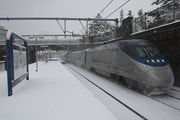
2002
In August 2002, shortly after their introduction, Acela Express trainsets were briefly removed from service when the brackets that connected truck (bogie) dampers (shocks) to the powerunit carbodies ("yaw dampers") were found to be cracking.[48][49] The trains were returned to service when a program of frequent inspections was instituted. The damper brackets have since been redesigned and the old brackets replaced with the newer design.
2005
On April 15, 2005, Acela Express trains were again removed from service when cracks were found in the disc brakes of most of the passenger coaches.[50][51] The Bombardier-Alstom consortium replaced the discs under warranty. Limited service resumed in July 2005, as a portion of the fleet operated with new brake discs.[52] Metroliner trains, which the Acela Express was intended to replace, filled in during the outage. Amtrak announced on September 21, 2005 that all 20 trainsets had been returned to full operation.
2008
The Acela Express between New York and Boston was taken offline June 16–19, 2008 when Amtrak replaced the drawbridge span of the 90-year-old Thames River Bridge with a new vertical lift span to improve the reliability of the bridge, reduce the chance of operational failures, and minimize train delays.[53] The outage was extended by two days due to complications with the removal of the bridge's counterweight.[54]
Incidents
2005
On September 28, 2005, a southbound train became the first Acela involved in a collision at a grade crossing when it struck a car at Miner Lane in Waterford, Connecticut,[55] one of the few remaining grade crossings on the Northeast Corridor (and one of the few on high-speed rail systems anywhere in the world). The train was approaching the crossing at approximately 70 miles per hour (110 km/h) when the car reportedly drifted under the crossing gate arms at a low speed and was struck by the train and dragged 1,000 feet (300 m). The driver, a 62-year-old woman, and her 8-year-old grandson, were killed instantly; a 4-year-old girl survived and was airlifted to a hospital where she died nine days later. The incident drew much criticism from the public about the 11 remaining grade crossings along Amtrak's busy Northeast Corridor, despite the fact the gates were later inspected and declared to have been functioning properly at the time of the incident.[56][57][58]
2008
On August 20, 2008, an Acela Express northbound train struck and fatally injured an Amtrak employee between the New Carrollton and Seabrook, Maryland, MARC Penn Line stops in suburban Washington.[59] The employee was airlifted to an area hospital before being pronounced dead; service on all trains was suspended for several hours.[60]
2010
According to news reports, at about 10:30 AM on Thursday, February 25, 2010, two teenage girls, 16-year-old Gina Gentile and 15-year-old Vanessa Dorwart, from Interboro Senior High School, in Norwood, Pennsylvania, outside of Philadelphia, committed suicide when they were struck by a southbound Acela Express train. Norwood's police chief said a search of the girls' e-mail and text messages revealed they had desired, for as-yet unknown motives, to end their lives. Their family members and classmates said that they had been upset over the death of Gentile's boyfriend the previous month when he was struck by a car while bicycling.[61]
Station stops
| State | Town/City | Station | Connections |
|---|---|---|---|
| Massachusetts | Boston | South Station | Amtrak: Lake Shore Limited, Northeast Regional MBTA Commuter Rail: Fairmount Line, Framingham/Worcester Line, Franklin Line, Needham Line, Old Colony Lines, Providence/Stoughton Line MBTA Bus Lines: 4, 6, 7, 11, 448, 449, 459 MBTA Subway Lines: Red Line, Silver Line (Waterfront) Intercity Buses: Greyhound Bus Lines, Peter Pan Bus Lines, Concord Coach Lines |
| Back Bay | Amtrak: Lake Shore Limited, Northeast Regional MBTA Commuter Rail: Framingham/Worcester Line, Franklin Line, Needham Line, Providence/Stoughton Line MBTA Bus Lines: 10, 39, 170 MBTA Subway Lines: Orange Line |
||
| Westwood | Route 128 | Amtrak: Northeast Regional MBTA Commuter Rail: Providence/Stoughton Line |
|
| Rhode Island | Providence | Providence | Amtrak: Northeast Regional MBTA Commuter Rail: Providence/Stoughton Line |
| Connecticut | New London (limited service) | New London | Amtrak: Northeast Regional ConnDOT: Shore Line East |
| New Haven | New Haven-Union Station | Amtrak: Shuttle, Vermonter Metro-North Railroad: New Haven Line ConnDOT: Shore Line East CT Transit New Haven: J, Commuter Connection Downtown and Sargent Drive, Temple Street Garage Shuttle Intercity Buses: Greyhound Bus Lines, Peter Pan Bus Lines |
|
| Stamford | Stamford | Amtrak: Northeast Regional, Vermonter Metro-North Railroad: New Haven Line ConnDOT: Shore Line East CT Transit Stamford: 11, 13, 14, 21, 22, 24, 31, 32, 33, 34, 41, 42, 43, 44, Commuter Connection Central, Commuter Connection-North, Commuter Connection Route 1 - East, Commuter Connection Bulls Head, I-Bus |
|
| New York | New York City | Penn Station | Amtrak: Adirondack, Cardinal, Carolinian, Crescent, Empire Service, Ethan Allen Express, Keystone Service, Lake Shore Limited, Maple Leaf, Palmetto, Pennsylvanian, Northeast Regional, Silver Meteor, Silver Star, Vermonter LIRR: Main Line, Port Washington Branch, Atlantic Branch, Montauk Branch NJ Transit: North Jersey Coast Line, Northeast Corridor Line, Gladstone Branch, Montclair-Boonton Line, Morristown Line NYC Subway: 1, 2, 3, A, C, E NYC Transit buses: M16, M20, M34, Q32 |
| New Jersey | Newark | Newark Penn Station | Amtrak: Cardinal, Carolinian, Crescent, Keystone Service, Pennsylvanian, Northeast Regional, Silver Meteor, Silver Star, Vermonter NJ Transit: Newark City Subway, Newark Light Rail, North Jersey Coast Line, Northeast Corridor Line, Raritan Valley Line, 5, 21, 62, 67, 70, 71, 72, 73, 75, 76, 78, 79, 308 PATH: NWK-WTC |
| Iselin | Metropark | Amtrak: Keystone Service, Northeast Regional, Vermonter NJ Transit: Northeast Corridor LineM 801, 802, 803, 804, 805 |
|
| Trenton | Trenton Rail Station | Amtrak: Cardinal, Carolinian, Crescent, Keystone Service, Pennsylvanian, Silver Star, Silver Meteor, Northeast Regional, Vermonter NJ Transit: Northeast Corridor Line, River Line, 409, 600, 604 SEPTA Regional Rail: Trenton Line SEPTA Suburban Transit Division: 127 |
|
| Pennsylvania | Philadelphia | 30th Street Station | Amtrak: Cardinal, Carolinian, Crescent, Keystone Service, Palmetto, Pennsylvanian, Northeast Regional, Silver Meteor, Silver Star, Vermonter NJ Transit: Atlantic City Line SEPTA City Transit Division: Market-Frankford Line, Route 10, Route 11, Route 13, Route 34, Route 36, 9, 30, 31, 44, 62, 121, 124, 125, 316 SEPTA Regional Rail: Airport Line, Warminster Line, Wilmington/Newark Line, West Trenton Line, Media/Elwyn Line, Lansdale/Doylestown Line, Paoli/Thorndale Line, Manayunk/Norristown Line, Cynwyd Line, Trenton Line, Chestnut Hill East Line, Chestnut Hill West Line, Fox Chase Line |
| Delaware | Wilmington | Wilmington Station | Amtrak: Cardinal, Carolinian, Crescent, Palmetto, Northeast Regional, Silver Meteor, Silver Star, Vermonter DART First State: 2, 6, 7, 10, 11, 12, 20, 21, 28, 32, 301 SEPTA Regional Rail: Wilmington/Newark Line |
| Maryland | Baltimore | Baltimore Penn Station | Amtrak: Cardinal, Carolinian, Crescent, Palmetto, Northeast Regional, Silver Meteor, Silver Star, Vermonter MARC Train: Penn Line MTA Maryland: Light Rail, 3, 11, 61, 64 |
| BWI Rail Station | Amtrak: Northeast Regional, Vermonter MARC Train: Penn Line MTA Maryland: 17 |
||
| District of Columbia | Washington | Washington Union Station | Amtrak: Capitol Limited, Cardinal, Carolinian, Crescent, Palmetto, Northeast Regional, Silver Meteor, Silver Star, Vermonter, Thruway Motorcoach to Charlottesville, Virginia MARC Train: Brunswick Line, Camden Line, Penn Line Metro: Red Line Metrobus: Loudoun, OmniRid VRE: Manassas Line, Fredericksburg Line |
Gallery
 Pair of trains at South Station Boston |
 Three Trainsets at South Station Boston |
 First class coach |
 Business class coach |
 Passage between cars |
 Café car |
See also
|
||||||||||||||||||||||||||||||
|
||||||||||||||||||||
|
||||||||||||||||||||
|
|||||
|
||||||||||||||||||||||||||
|
|||||||||||||||||||||||||||||||||||||||||||||
|
||||||||||||||||||||||||||||||
|
|||||||||||||||||||||||||||||
References
- ↑ 1.0 1.1 "Amtrak posts second-best ridership in history". Amtrak. October 12, 2009. http://www.amtrak.com/servlet/BlobServer?blobcol=urldata&blobtable=MungoBlobs&blobkey=id&blobwhere=1249200496643&blobheader=application%2Fpdf&blobheadername1=Content-disposition&blobheadervalue1=attachment;filename=Amtrak_ATK-09-074_FY09_Riders. Retrieved 2010-02-03.
- ↑ http://www.amtrak.com/servlet/BlobServer?blobcol=urldata&blobtable=MungoBlobs&blobkey=id&blobwhere=1249208753577&blobheader=application%2Fpdf&blobheadername1=Content-disposition&blobheadervalue1=attachment;filename=Amtrak_W04.pdf
- ↑ 3.0 3.1 "All Aboard Amtrak's Acela". Washington Post (2000). Click on "Continue", then on "Staying Steady". http://www.washingtonpost.com/wp-srv/travel/features/acelaflash.htm. Retrieved 2008-09-30.
- ↑ Goldberg, Bruce. "Metroliner's Amazing Rave." Trains June 2006 (53)
- ↑ "On One Key Route, Amtrak is Up, Airlines Down". Wired. Conde Nast Publications. March 21, 2008. http://www.wired.com/autopia/2008/03/would-people-av/. Retrieved February 2, 2010. for Acela express passenger numbers only
- ↑ "The Information: Most popular airline routes". Financial Times. January 17, 2009. http://www.ft.com/cms/s/2/ea790b66-e29a-11dd-b1dd-0000779fd2ac.html. Retrieved February 2, 2010.
- ↑ "Amtrak unveils high-speed shuttle trains for busy travelers - Service between Boston, Washington is designed to compete with airlines". Milwaukee Journal Sentinel. March 10, 1999. http://www.highbeam.com/doc/1P2-6680582.html. Retrieved 2009-08-29.
- ↑ 8.0 8.1 "Amtrak To Unveil High-Speed Service". Associated Press. March 9, 1999. http://www.highbeam.com/doc/1P1-23407520.html. Retrieved 2009-08-29.
- ↑ "At-grade crossings: Innovation, safety, sophisticated new technology". Railway Track and Structures. June 01, 1999. http://www.accessmylibrary.com/coms2/summary_0286-31928865_ITM. Retrieved 2009-08-29.
- ↑ 10.0 10.1 "Acela, Built to Be Rail's Savior, Bedevils Amtrak at Every Turn". New York Times. April 24, 2005. http://query.nytimes.com/gst/fullpage.html?res=9506EEDB1531F937A15757C0A9639C8B63. Retrieved 2009-08-29.
- ↑ Ramstack, Tom (March 19, 2004). "Amtrak Reaches Settlement with Manufacturers of Acela Express". Washington Times. http://www.accessmylibrary.com/article-1G1-118690539/amtrak-reaches-settlement-manufacturers.html. Retrieved 2009-08-29.
- ↑ "Amtrak and Bombardier/Alstom Consortium Announce Resolution of Legal Claims". euronext.com. March 17, 2004. http://www.euronext.com/fic/000/003/111/31116.pdf. Retrieved 2009-08-29.
- ↑ "U.S. Transportation Secretary Slater celebrates inaugural run of Acela Express high-speed rail service". M2 Presswire. November 17, 2000. http://www.highbeam.com/doc/1G1-67162158.html. Retrieved 2009-08-29.
- ↑ "Amtrak postpones debut of high-speed rail line". Business Courier Serving Cincinnati - Northern Kentucky. March 3, 2000. http://www.accessmylibrary.com/coms2/summary_0286-27577035_ITM. Retrieved 2009-08-29.
- ↑ R. Clifford Black (March 2005). The Acela Express. Japan Railway & Transport Review. http://www.jrtr.net/jrtr40/pdf/f18_bla.pdf. Retrieved 2009-08-29.
- ↑ MacHalaba, Daniel (March 28, 1999). "Metroliner name on past track". Chicago Tribune. http://pqasb.pqarchiver.com/chicagotribune/access/40077835.html?dids=40077835:40077835&FMT=ABS&FMTS=ABS:FT&type=current&date=Mar+28%2C+1999&author=Daniel+Machalaba%2C+The+Wall+Street+Journal&pub=Chicago+Tribune&desc=METROLINER+NAME+ON+PAST+TRACK&pqatl=google. Retrieved 2009-08-29.
- ↑ "Amtrak to run last Metroliner". Trains.com. 2006-09-08. http://www.trains.com/trn/default.aspx?c=a&id=795. Retrieved 2006-09-08.
- ↑ Carr, David (October 2001). "Slower Than A Speeding Bullet - Acela, Amtrak's new train". Washington Monthly. http://findarticles.com/p/articles/mi_m1316/is_10_33/ai_79515174/. Retrieved 2009-08-30.
- ↑ "Amtrak to increase service for Boston, New York and D.C.". Boston Business Journal. September 8, 2005. http://www.bizjournals.com/boston/stories/2005/09/05/daily34.html?from_rss=1. Retrieved 2009-08-29.
- ↑ "Acela Trains may expand to meet demand". Boston Globe/Bloomberg News. August 27, 2008. http://www.boston.com/business/articles/2008/08/27/acela_trains_may_expand_to_meet_demand/. Retrieved 2009-08-29.
- ↑ "All Aboard: Too many for Amtrak - Surge in ridership leads to crowding on Intercity trains". Wall Street Journal. August 27, 2008. http://online.wsj.com/public/article_print/SB121815170729322339.html. Retrieved 2009-08-29.
- ↑ "New trains, new name for Northeast Corridor: Amtrak's High-speed Acela service is due later this year". Philadelphia Inquirer. March 10, 1999. http://nl.newsbank.com/nl-search/we/Archives?p_product=PI&s_site=philly&p_multi=PI&p_theme=realcities&p_action=search&p_maxdocs=200&p_topdoc=1&p_text_direct-0=0EB5CDDDC734C540&p_field_direct-0=document_id&p_perpage=10&p_sort=YMD_date:D&s_trackval=GooglePM. Retrieved 2009-05-02.
- ↑ Garland, Russell (March 12, 1999). "Amtrak switch: Is it on the right track? Advertising people say the new Acela name gives a mixed message". Providence Journal. http://pqasb.pqarchiver.com/projo/access/44920648.html?dids=44920648:44920648&FMT=ABS&FMTS=ABS:FT&type=current&date=Mar+12%2C+1999&author=Garland%2C+Russell&pub=The+Providence+Journal&desc=Amtrak+switch%3A+Is+it+on+the+right+track%3F+Advertising+people+say+the+new+Acela+name+gives+a+mixed+message&pqatl=google. Retrieved 2009-08-29.
- ↑ Jay Jochnowitz (1999-03-10). "New Amtrak trains on fast track". Times Union: p. A1.
- ↑ "Acela". Corporate Design Foundation. http://www.cdf.org/issue_journal/acela.html. Retrieved 2009-05-02.
- ↑ Vantuono, William (April 01, 1999). "Amtrak's vision: Today, the Northeast. Tomorrow America". Railway Age. http://www.accessmylibrary.com/coms2/summary_0286-31922649_ITM. Retrieved 2009-08-29.
- ↑ "Amtrak begins Phila-Boston service that's 45 minutes faster "Acela Regionals" go into service as the first step in improvements on the Northeast Corridor line". Philadelphia Inquirer. February 1, 2000. http://nl.newsbank.com/nl-search/we/Archives?p_product=PI&s_site=philly&p_multi=PI&p_theme=realcities&p_action=search&p_maxdocs=200&p_topdoc=1&p_text_direct-0=0EB735098C4CB57B&p_field_direct-0=document_id&p_perpage=10&p_sort=YMD_date:D&s_trackval=GooglePM. Retrieved 2009-08-30.
- ↑ Bob Johnston, Amtrak opens Boston electrification, Trains April 2000
- ↑ Ron Newman, Acela Regional starts January 31, 2000, misc.transport.rail.americas January 27, 2000
- ↑ Laurence Arnold (2003-03-05). "Amtrak will use name 'Acela' to describe high-speed trains only". Associated Press.
- ↑ McCaughrin, Eric (March 5, 2007). "How the FRA is Regulating Passenger Rail Out of Existence". East Bay Bicycle Coalition. http://www.ebbc.org/rail/fra.html.
- ↑ "Bombardier unveils new JetTrain locomotive". International Railway Journal. November 2002. http://findarticles.com/p/articles/mi_m0BQQ/is_11_42/ai_99569317/.
- ↑ "High wire to efficiency". Railway Age. March 01, 1992. http://www.accessmylibrary.com/coms2/summary_0286-31942034_ITM. Retrieved 2009-08-29.
- ↑ "Northeast Corridor timetable" (PDF). Amtrak. 2008-08-04. http://www.amtrak.com/timetable/aug08/W02.pdf. Retrieved 2008-08-08.
- ↑ "Moynihan Station". empire.state.ny.us. http://www.empire.state.ny.us/moynihanstation/default.asp. Retrieved November 28, 2007.
- ↑ Jane Dee (March 29, 1999). "Rail crossings safety concern for Amtrak". Hartford Courant. http://pqasb.pqarchiver.com/courant/access/40117741.html?dids=40117741:40117741&FMT=ABS&FMTS=ABS:FT&type=current&date=Mar+29%2C+1999&author=JANE+E.+DEE%3B+Courant+Staff+Writer&pub=Hartford+Courant&desc=RAIL+CROSSINGS+SAFETY+ISSUE+FOR+AMTRAK&pqatl=google. Retrieved 2009-08-29.
- ↑ "U.S. DOT: America's first "smart" highway-rail crossing is dedicated in Groton, Connecticut". M2 Presswire. August 27, 1998. http://www.highbeam.com/doc/1G1-53008353.html. Retrieved 2009-08-29.
- ↑ "Virgin train breaks speed record". BBC News. 2006-09-22. http://news.bbc.co.uk/1/hi/scotland/glasgow_and_west/5369808.stm. Retrieved 2009-08-29.
- ↑ 39.0 39.1 "Inside the Acela". Washington Post. 2000-11-30. http://www.washingtonpost.com/wp-srv/travel/features/acelaflash.htm. Retrieved 2009-08-29.
- ↑ 40.0 40.1 "Acela Article". railfaneurope.net. http://www.railfaneurope.net/tgv/acela.html. Retrieved 2009-08-29.
- ↑ "TGV Pages - Acela". Trainweb.org. http://www.trainweb.org/tgvpages/acela.html. Retrieved 2009-08-29.
- ↑ Dao, James (2005-04-24). "Acela, Built to Be Rail's Savior, Bedevils Amtrak at Every Turn". The New York Times. http://www.nytimes.com/2005/04/24/national/24acela.html&OQ=_rQ3D1&OP=dcc795Q2FzmQ5DQ23zVcQ7BTjccQ22DzDBBQ60zBHzDHzxQ7DQ22Q3CcxQ7D.zDHQ7DQ7BQ5D.Q7DiQ5BQ22Q20.. Retrieved 2008-03-04.
- ↑ Laurence Arnold (2001-12-11). "Fast train begins service with Washington-Boston roundtrip". Associated Press.
- ↑ Glenn Fleishman (July 8, 2004). "Behind the Curve; Access on Metro-North or Amtrak Cars? Not So Fast". New York Times. http://query.nytimes.com/gst/fullpage.html?res=9B00E0DC153BF93BA35754C0A9629C8B63.
- ↑ Eric Anderson (March 11, 2007). "Amtrak expects to boost services: Wireless Internet, new leather seats among possible perks". Times Union (Albany, NY). http://www.accessmylibrary.com/coms2/summary_0286-29935313_ITM.
- ↑ "Amtrak plans Wi-Fi, more security". washington.bizjournals.com. http://washington.bizjournals.com/washington/stories/2009/10/26/daily96.html. Retrieved 2009-11-09.
- ↑ Amtrak (March 1, 2010). "Amtrak Launches Wi-Fi Service" (PDF). Press release. http://www.amtrak.com/servlet/BlobServer?blobcol=urldata&blobtable=MungoBlobs&blobkey=id&blobwhere=1249206409409&blobheader=application%2Fpdf&blobheadername1=Content-disposition&blobheadervalue1=attachment;filename=Amtrak_ATK-10-020_WiFi_on_Acela_030110_FINAL.pdf. Retrieved 2010-03-27.
- ↑ "Discovery of hairline cracks causes more problems for Amtrak's Acela Express". USA Today. August 20, 2002. http://www.usatoday.com/travel/news/2002/2002-08-20-acela-woes.htm. Retrieved 2009-08-29.
- ↑ Daniel, Mac (August 14, 2002). "Flaws Shut Down Amtrak's Acela Express Line". Boston Globe. http://www.accessmylibrary.com/coms2/summary_0286-8810199_ITM. Retrieved 2009-08-29.
- ↑ "Service Alert: Acela Express - Amtrak Cancels All Friday and Saturday Acela Express Service Due to Brake Problem". Amtrak. http://www.amtrak.com/servlet/ContentServer?pagename=Amtrak/am2Copy/Simple_Copy_Page&cid=1093553993887. Retrieved April 15, 2005,.
- ↑ Hauser, Kristine (2005-04-15). "Amtrak Suspends Acela Trains After Finding Brake Problems". New York Times. http://www.nytimes.com/2005/04/15/national/15cnd-amtr.html?ex=1125720000. Retrieved April 15, 2005.
- ↑ Reed, Keith (June 10, 2005). "Acela's return expected in July". Boston Globe. http://www.accessmylibrary.com/article-1G1-133125089/acela-return-expected-july.html. Retrieved 2009-08-29.
- ↑ Amtrak (2008-05-28). "Thames River Bridge to be Closed to Rail Traffic June 14–17 for Replacement of 90-Year-Old Vertical Lift Span". Press release. http://www.amtrak.com/servlet/ContentServer?pagename=Amtrak/am2Copy/News_Release_Page&c=am2Copy&cid=1178294166689. Retrieved 2008-09-03.
- ↑ "Archived Newstory on Thames River Bridge replacement". theday.com. http://www.theday.com/re.aspx?re=e68454c8-7184-4e05-9d45-8b9828a3f4b5. Retrieved 2009-08-29.
- ↑ McGeehan, Patrick, and Wald, Matthew L. (2005-09-30). "High-Tech Gates Fail to Avert Car-Train Crash". The New York Times. http://www.nytimes.com/2005/09/30/nyregion/30acela.html?_r=1&oref=slogin. Retrieved 2008-09-02.
- ↑ Associated Press (2006-12-27). "Family sues over fatal car crash on railroad tracks". Boston Globe. http://www.boston.com/news/local/connecticut/articles/2006/12/27/family_sues_over_fatal_car_crash_on_railroad_tracks/. Retrieved 2007-05-22.
- ↑ "Amtrak train, car collide, killing two". WTNH. 2005-09-28. http://www.wtnh.com/global/story.asp?s=3908855&ClientType=Printable. Retrieved 2007-05-22.
- ↑ "Investigators Seek Answers In Fatal Crash That Killed Two; Cause of Waterford car-train accident may never be known". The New London Day. 2005-09-30. http://www.axthetax.org/commuter-rail/_12.html. Retrieved 2007-05-22.
- ↑ "Amtrak worker dies after being struck by Acela train". Baltimore Sun. 2008-08-20. http://www.baltimoresun.com/news/traffic/bal-marc0820,0,5946386.story. Retrieved 2008-08-20.
- ↑ "Rail traffic on Washington-Baltimore line halted this morning after person struck by train". Herald-Mail. 2008-08-20. http://www.herald-mail.com/?cmd=displaystory&story_id=201496&format=html. Retrieved 2009-08-30.
- ↑ "Officials: Pa. train deaths a suicide". Associated Press. February 28, 2010. http://www.usatoday.com/news/nation/2010-02-28-train-suicides-pa_N.htm. Retrieved 1 March 2010.
Further reading
- Solomon, Brian (2004). Amtrak. MBI Publishing. ISBN 0760317658.
- Vranich, Joseph (2004). End of the line: the failure of Amtrak reform and the future of America's passenger trains. AEI Press. ISBN 0844742031.
